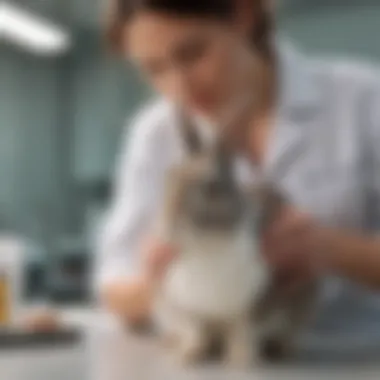Spaying Female Rabbits: Procedure and Implications


Intro
Spaying female rabbits is a crucial aspect of responsible pet ownership. It is a surgical procedure that can significantly improve the health and behavior of your rabbit. Knowing the motivations for spaying, the process involved, and the post-operative care can empower pet owners to make informed choices. This article serves as a comprehensive guide, aiming to shed light on the procedure and address common myths surrounding it.
Understanding Your Pet
Pet Behavior Basics
Understanding rabbit behavior is essential for any owner. Rabbits are social creatures that require interaction, both with humans and other rabbits. Their behaviors can often reflect their emotional states. For instance, a rabbit that is digging or chewing furniture may be bored or anxious. Recognizing these signs allows for timely intervention, whether through enriched environments or social opportunities.
Common Breed Characteristics
Different rabbit breeds possess unique characteristics. Breeds such as the Holland Lop are known for their docility and friendliness, while the Rex is recognized for its playful nature. Understanding these traits enables pet owners to tailor care and enrichment to their rabbit’s specific needs. This knowledge is particularly useful when considering spaying, as some breeds may have distinct health considerations.
Species-Specific Needs
Rabbits have specific dietary needs that can influence their overall health and behavior. They require a high-fiber diet primarily composed of hay, supplemented with fresh greens and limited pellets. Knowledge of these requirements is essential, particularly in the context of recovery post-spaying, as some changes may be necessary in their diet or care routine.
Pet Care and Maintenance
Feeding Guidelines
Feeding a rabbit requires careful consideration of their dietary needs. High-quality hay should form the basis of their diet, as it promotes good digestive health. Fresh, leafy greens can be offered daily, while pellets should be a smaller part of their diet. These guidelines assist in maintaining a healthy weight and preparing for spaying by ensuring the rabbit is in good condition.
Grooming Essentials
Regular grooming is vital for maintaining a rabbit’s coat and overall well-being. Long-haired breeds require more frequent brushing to prevent matting, while short-haired rabbits benefit from occasional brushing. This care helps prevent health issues and enhances bonding time with your pet.
Hygiene Practices
Routine hygiene is important for rabbit health. Litter box training is essential, and cleaning the box regularly prevents odor and keeps your rabbit healthy. Bathing rabbits is generally discouraged; rather, focus on keeping their environment clean.
Health and Wellness
Routine Vet Check-ups
Regular veterinary check-ups are crucial for early detection of health issues. These visits are particularly important before and after spaying, ensuring that your rabbit is fit for surgery and monitoring recovery.
Vaccination Needs
Vaccination against diseases such as rabbit hemorrhagic disease is essential. Keeping up with vaccinations is part of a responsible care routine and helps protect your pet against common illnesses.
Recognizing Signs of Illness
Knowing the signs of illness in rabbits is vital for proper health management. Symptoms such as lethargy, changes in eating habits, or unusual behaviors should prompt a visit to the veterinarian. Early detection can prevent potentially serious health challenges.
Enrichment and Activities
Indoor vs. Outdoor Activities
Indoor rabbits require different types of enrichment compared to those that have outdoor access. Indoor activities can include tunnels and chew toys, while outdoor rabbits can benefit from supervised play. Each environment offers unique opportunities for physical exercise and mental stimulation.
Interactive Toys and Games
Providing interactive toys is important for keeping rabbits engaged. Toys that encourage digging or chewing are great options. Providing these can help reduce boredom and anxiety, contributing to overall well-being.
Socialization Opportunities


Socialization is key for a rabbit's happiness. They are social animals and enjoy the companionship of humans and other rabbits. Introducing them to safe, gentle interactions can enhance their emotional health, making the spaying process less stressful.
Spaying can lead to significant behavioral improvements and help with health issues.
Understanding these fundamental aspects of rabbit care helps prepare pet owners for the journey of spaying. The integration of proper care before and after the procedure is essential for the long-term health of your rabbit.
Prologue to Spaying Female Rabbits
Spaying female rabbits is an important aspect of responsible pet ownership. As guardians of these delicate creatures, knowing about spaying is essential for their health and well-being. This section offers a deeper insight into what spaying entails and why it is significant for rabbit owners.
Definition of Spaying
Spaying refers to the surgical removal of a female rabbit's reproductive organs, including the ovaries and usually the uterus. This procedure is also known as ovariohysterectomy. The goal of spaying is to eliminate the possibility of unwanted litters and reduce the risk of several health issues. By removing the reproductive organs, hormone levels in the rabbit stabilize, preventing many behavioral problems associated with the reproductive cycle.
Relevance for Rabbit Owners
For rabbit owners, engaging in the practice of spaying can lead to a host of benefits.
- Health Benefits: Spaying has been linked to a reduced risk of uterine cancer and other serious health conditions in female rabbits. This makes it a crucial health measure that can significantly extend the pet’s life.
- Behavior Management: Many spay their rabbits to control undesirable behaviors such as aggression or territory marking that can arise when a rabbit is in heat.
- Population Control: With many unwanted rabbits in shelters, spaying helps control the population. Responsible owners reduce the likelihood of contributing to the problem of overpopulation.
Ultimately, spaying can lead to a more balanced and harmonious relationship between pet and owner.
The Importance of Spaying Female Rabbits
Spaying female rabbits is a critical aspect of responsible pet ownership. This procedure affects the health, behavior, and overall well-being of the animal, while also addressing broader issues such as population control. Understanding the myriad of benefits associated with spaying can guide rabbit owners in making informed decisions for their pets. Each of the following subsections will elaborate on specific elements that signify the importance of spaying.
Health Benefits
One of the foremost reasons to consider spaying is the significant health benefits it offers. Female rabbits are prone to certain reproductive health issues, including uterine tumors and infections. According to various veterinarians, spaying eliminates the risk of these conditions entirely. In addition to preventing cancer, spaying can help mitigate other health risks that stem from hormonal fluctuations.
Furthermore, spaying often contributes to improved longevity. Studies suggest that female rabbits that undergo this procedure generally live healthier and longer lives. Thus, for pet owners, opting for spaying not only safeguards against potential health pitfalls but also enhances the quality of life for their rabbits.
"Spaying a female rabbit can greatly improve her health and increase her lifespan; it is a preventive measure against serious illnesses."
Behavioral Changes
Understanding the behavioral transformations that can result from spaying is equally important. Unspayed female rabbits often exhibit territorial behaviors, which can manifest as aggression or destructive tendencies. Some may become more vocal or display anxiety when they are in heat. Spaying effectively eliminates these hormonal influences, leading to a calmer and more sociable temperament. Owners frequently notice that their spayed rabbits are more affectionate and easier to handle.
Another common behavioral benefit is a reduction in marking territory. Spayed rabbits tend to stop this behavior, which can be a relief to owners concerned about their home environments. This increase in tranquility contributes to a better bond between pet and owner, fostering a harmonious household.
Population Control
The issue of rabbit overpopulation cannot be overlooked. With one unspayed female able to produce numerous offspring in a year, the potential for exponential growth in rabbit populations is alarming. Shelters are often overwhelmed with abandoned rabbits, many of which are a result of unwanted litters. Spaying is an essential measure in controlling this population influx.
By choosing to spay, pet owners actively contribute to a more sustainable rabbit population. They take responsible steps to ensure that their pet's offspring do not contribute to the already significant issue of pet overpopulation in communities. Taking this action creates a positive ripple effect, aiding efforts to manage rabbit populations effectively.
Understanding the Spaying Procedure
Understanding the spaying procedure is critical for any rabbit owner. This section outlines the various components of the surgery, preparation involved, and the overall process. It helps inform pet owners about what to expect, highlighting important aspects such as the role of anesthesia and monitoring during surgery, as well as the recovery process. Awareness of these elements aids in ensuring a successful outcome for the rabbit's health.
Preparation for Surgery
Before the surgery, careful preparation is necessary to ensure the safety and success of the procedure. Firstly, scheduling a pre-operative consultation with a veterinarian is essential. During this consultation, the vet assesses the health of the rabbit and determines if they are fit for surgery. This might include blood work to check for any underlying health issues.
- Fasting: Rabbits often do not need to fast before surgery like other animals, but vets might recommend limited food a few hours prior.
- Environment: It is useful to prepare a quiet, comfortable space at home for post-surgery recovery. This will help reduce stress for the rabbit.
It is also advisable to gather any necessary supplies, such as clean bedding, food, and medications that may be prescribed for pain relief. In some cases, the vet may instruct the owner on specific care instructions prior to the surgery.
Surgical Process Overview


The surgical procedure itself typically involves a few critical steps performed under a sterile environment. The veterinarian begins by administering anesthetics to ensure the rabbit remains unconscious and pain-free throughout the operation. This is followed by:
- Incision: The vet makes a small incision in the abdominal wall, allowing access to the reproductive organs.
- Removal of Ovaries and Uterus: The ovaries and uterus are carefully removed to prevent future pregnancies and reduce health risks.
- Closing the Incision: After the organs are removed, the incision is stitched or stapled closed, ensuring minimal bleeding and allowing proper healing.
The duration of the surgery is usually relatively short, often lasting between 30 minutes to an hour depending on the specific case.
Anesthesia and Monitoring
Anesthesia is a critical part of the spaying procedure, as it ensures the rabbit does not experience pain during surgery. Generally, a combination of inhalant and injectable anesthetics is used to provide safe and effective sedation.
Post-anesthesia, monitoring becomes essential. Veterinarians or trained staff must keep a close eye on the rabbit's vital signs:
- Heart Rate
- Respiration Rate
- Temperature
These measurements ensure the rabbit is recovering well after surgery. Once the rabbit is stable and waking up from anesthesia, it is typically moved to a recovery area where it can be observed closely. Proper monitoring reduces the risk of complications post-surgery and aids in a smooth recovery.
Risks and Considerations Associated with Spaying
Spaying female rabbits is an important procedure that comes with its own set of risks and considerations. Understanding these elements is crucial for pet owners who wish to make informed decisions about their rabbit's health and wellbeing. While the benefits of spaying are often emphasized, it is equally important to recognize and evaluate the possible complications and long-term implications that may arise.
Potential Complications
Complications can occur during or after the spaying procedure. Some of the potential risks include:
- Anesthesia Risks: Anesthesia is necessary for spaying, and there are inherent risks. Rabbits can have adverse reactions, particularly if they have preexisting health issues.
- Surgical Risks: Just like any surgery, there is a chance of infection or complications arising from the surgical incision. Proper sterilization techniques and post-operative care are essential to mitigate these risks.
- Internal Bleeding: This can happen if a blood vessel is not properly sealed during surgery. It may lead to severe health issues if not promptly addressed.
- Pain and Discomfort: After surgery, rabbits may experience pain or discomfort. Recognizing signs of distress is vital for timely intervention.
Pet owners should communicate with their veterinarian about any concerns they might have regarding the surgery. Ensuring the veterinarian has experience with rabbit surgeries can help minimize risks.
Long-term Implications
In addition to immediate complications, spaying can have long-term implications for a rabbit's health and behavior. Some of these include:
- Hormonal Changes: Spaying removes reproductive hormones, which can lead to changes in behavior. Some rabbits may become calmer, while others might show signs of depression or anxiety.
- Weight Management: Post-spaying, some rabbits may be prone to weight gain. This occurs typically due to decreased activity levels or changes in metabolism. It is crucial for owners to monitor their rabbit's diet and exercise.
- Health Benefits: On a positive note, spaying significantly reduces the risk of uterine cancer and other reproductive system disorders. An informed decision requires balancing both the risks and benefits associated with this procedure.
"Understanding the risks associated with spaying allows owners to act proactively and make the best choices for their rabbits' health."
Considering these risks before spaying can help pet owners prepare mentally and logistically for their bun's recovery. A comprehensive discussion with a veterinarian can lay out the specific risks based on the individual rabbit's health and age.
Timing for Spaying Female Rabbits
The timing of spaying female rabbits is a critical aspect of responsible pet ownership. It plays a significant role in determining both the short-term and long-term health of the rabbit. Recognizing the optimal age for surgery helps ensure the best outcomes, while also considering the unique needs of mature rabbits can influence their overall well-being.
Optimal Age for Surgery
The ideal time to spay a female rabbit usually falls between four to six months of age. At this stage, the rabbit reaches sexual maturity, and this is when behaviors associated with hormonal changes, such as marking territory and aggression, may begin to emerge. Spaying at this age can prevent these behaviors from developing, making it easier to integrate the rabbit into the home environment.
Spaying during this time also offers health benefits. It significantly reduces the risk of uterine infections and cancers, which are common in unspayed females. Addressing these health concerns early can lead to a longer, healthier life for the rabbit. Moreover, younger rabbits generally recover more quickly from surgical procedures, which can be less stressful for both the animal and the owner.
Considerations for Mature Rabbits
When it comes to mature rabbits, spaying can still be beneficial but requires careful consideration. Mature rabbits may be six months old or older, and the risks associated with surgery often increase with age. As rabbits grow older, they may develop underlying health issues that could complicate anesthesia and recovery. However, spaying these rabbits can still provide essential health benefits and improve behavioral issues.
For owners with older rabbits, a vet consultation is paramount before proceeding with surgery. The vet can evaluate the rabbit’s health and determine if spaying is advisable. If decided upon, additional pre-operative testing may be needed to ensure the rabbit can tolerate the procedure safely.
"Spaying female rabbits at the appropriate time not only prevents unwanted litters but also fosters better health and behavior throughout their lives."
Post-operative Care for Spayed Rabbits


Post-operative care is crucial after spaying a female rabbit. The initial recovery after surgery plays a key role in ensuring the rabbit's health and well-being. Proper care helps to minimize discomfort and prevent complications, which contributes to a smoother recovery process. In this section, we will discuss the essential steps required for effective post-operative care, focusing on the initial recovery period and long-term care guidelines.
Initial Recovery Period
The initial recovery period is the first few days following the spaying surgery. During this time, the rabbit will need a quiet and safe space for recovery. Here are important considerations:
- Monitor Activity Level: It is advisable to limit the rabbit's activity immediately after surgery. Encourage rest by providing a comfortable, enclosed area.
- Check Surgical Site: Inspect the incision daily for any signs of infection or unusual swelling. Redness or discharge can indicate a problem.
- Hydration and Nutrition: Ensure that clean water is available at all times. Offer easily accessible food, such as hay or pellets, to encourage eating. Appetite may decrease at first but should gradually improve.
- Pain Management: Consult with the veterinarian about pain management options. They may prescribe pain relief medication to help minimize discomfort.
- Avoid Bathing: It is vital to keep the surgical site clean and dry. Bathing is not recommended, as water may interfere with healing.
"Proper post-operative care is essential to prevent complications and support recovery."
Long-term Care Guidelines
Once the initial recovery is over, long-term care becomes important for the rabbit's overall health. Here are some guidelines to follow:
- Regular Check-ups: Schedule follow-up appointments with a veterinarian to ensure the incision is healing properly. Regular health checks can help in identifying any underlying issues early.
- Balanced Diet: Maintain ahealthy diet that includes fresh vegetables, hay, and high-quality pellets. Good nutrition helps support recovery and overall wellbeing.
- Monitor Behavior: Keep an eye on the rabbit's behavior. Changes in activity, eating habits, or litter box usage may signal health problems.
- Provide Enrichment: Engaging the rabbit in safe play or enrichment activities can help improve its mood and physical health. Use toys and tunnels designed for rabbits.
- Spay Complications Awareness: Be aware of potential long-term complications, such as hormonal changes affecting behavior, and consult your veterinarian if you notice any severe issues.
Following these steps will enhance the post-operative recovery for spayed rabbits, leading to healthier lives and more balanced behaviors. Overall, attentive care during this period is vital for successful spaying.
Common Misconceptions about Spaying
Understanding the common misconceptions surrounding spaying female rabbits is crucial for responsible pet ownership. Many owners hold misleading beliefs about the process and its implications. These misconceptions can lead to hesitation in taking necessary actions for the health and well-being of their pets. Clear and factual information can empower rabbit owners to make informed decisions.
Spaying Decreases Lifespan
One widespread myth is that spaying a female rabbit shortens her lifespan. In truth, spaying can actually extend a rabbit's life. Female rabbits are at risk for certain reproductive health issues such as uterine cancer. Research suggests that spaying significantly reduces the incidence of these conditions. By eliminating risks, spayed rabbits may live longer, healthier lives. Moreover, spaying can reduce behavioral issues stemming from hormonal changes, promoting a calmer disposition. Thus, the belief that spaying negatively affects lifespan lacks empirical support and often arises from misunderstanding.
Weight Gain Post-spaying
Another common misconception is that spaying leads to excessive weight gain in rabbits. While hormonal changes after surgery can affect metabolism, the weight gain is not inevitable. Instead, owners play a pivotal role in managing post-surgical weight through proper diet and exercise. It is essential to monitor a spayed rabbit's caloric intake and provide plenty of opportunities for physical activity. Many spayed rabbits maintain a healthy weight with appropriate care. Therefore, instead of fearing weight gain, owners should focus on balanced nutrition and an active lifestyle for their pets, dispelling the myth that spaying leads directly to obesity.
This understanding empowers rabbit owners to ensure their pets thrive after spaying.
By addressing these misconceptions, it is possible to alleviate concerns and promote spaying as a beneficial procedure for female rabbits. With the right knowledge, owners can confidently navigate the process, prioritizing their rabbit's health and happiness.
Alternatives to Spaying
Considering alternatives to spaying female rabbits is essential for pet owners who want to make informed decisions about their pets' health and well-being. While spaying can provide numerous benefits, some owners may seek other options for various personal or philosophical reasons. Understanding these alternatives can help in reaching a decision that best aligns with the owner’s values and the rabbit’s health needs.
Natural Breeding Considerations
Natural breeding is one alternative to spaying. Rabbits, by nature, are prolific breeders. Allowing a rabbit to breed can be seen as a way to maintain its natural instincts and fulfill its reproductive desires. However, this choice comes with significant responsibilities. Owners must consider the potential for an unplanned population explosion. Each litter can consist of several bunnies, and managing the care of numerous young rabbits can become overwhelming.
Moreover, breeding can introduce health concerns for both the mother and her offspring. Female rabbits may experience pregnancy-related issues and possible complications during birth. Potential genetic disorders in young rabbits can arise if breeding is not managed responsibly. It is essential for a breeder to understand genetics to make informed decisions about compatible pairs. Therefore, those opting for natural breeding must be prepared for the complex realities of rabbit care.
Non-invasive Alternatives
For those who seek to avoid the risks associated with surgical procedures without resorting to natural breeding, non-invasive alternatives are an option. One common alternative is hormonal treatments that aim to manage reproductive cycles. These treatments can help in preventing unwanted pregnancies while minimizing the risks linked with surgical spaying. Nonetheless, it is important to discuss these options with a veterinarian to understand the potential side effects, as long-term use of hormonal treatments can lead to other health issues.
Additionally, behavioral interventions can also aid in managing the reproductive behaviors of unspayed females. Providing ample enrichment and social interaction with compatible companions might keep the rabbit engaged and reduce some urges related to mating.
The End
Spaying female rabbits is an essential aspect of responsible rabbit ownership. This procedure not only enhances the health and well-being of the pet but also contributes positively to the overall dynamics of pet ownership. Evaluating the multiple benefits of spaying highlights its critical nature in rabbit care. It reduces the likelihood of certain medical conditions, curbs hormonal-driven behaviors, and plays a significant role in controlling unwanted rabbit populations.
Recap of Key Points
- Health Advantages: Spaying significantly lowers the risks of uterine cancer and eliminates the risk of ovarian cancers. Such prevention is crucial for extending the lifespan of female rabbits.
- Behavioral Changes: Post-spaying, female rabbits tend to experience calmer temperaments. This can translate to less aggression and unwanted territorial behaviors, making them more enjoyable companions.
- Population Control: With rising numbers of abandoned and neglected rabbits, spaying serves as an effective means of controlling pet populations. This contributes to a global effort of reducing the number of homeless rabbits in shelters.
Final Thoughts on Responsible Rabbit Ownership
In the realm of responsible rabbit ownership, spaying stands out as a pivotal consideration. The commitment involves understanding the comprehensive needs of these animals. Owners must recognize that a spayed rabbit not only leads to a healthier animal but fosters a more harmonious living environment. Additionally, being informed enables better decision-making regarding care and companionship. Encouraging responsible practices, such as advocacy for spaying, is essential.
"Understanding the health and behavioral benefits of spaying, along with the importance of population control, highlights the responsibility of rabbit owners to make informed choices for their pets."
Responsible rabbit ownership involves proactive measures. This includes not just spaying, but ongoing education about their health, behavior, and well-being. Spaying is a straightforward yet impactful decision for the welfare of female rabbits.







